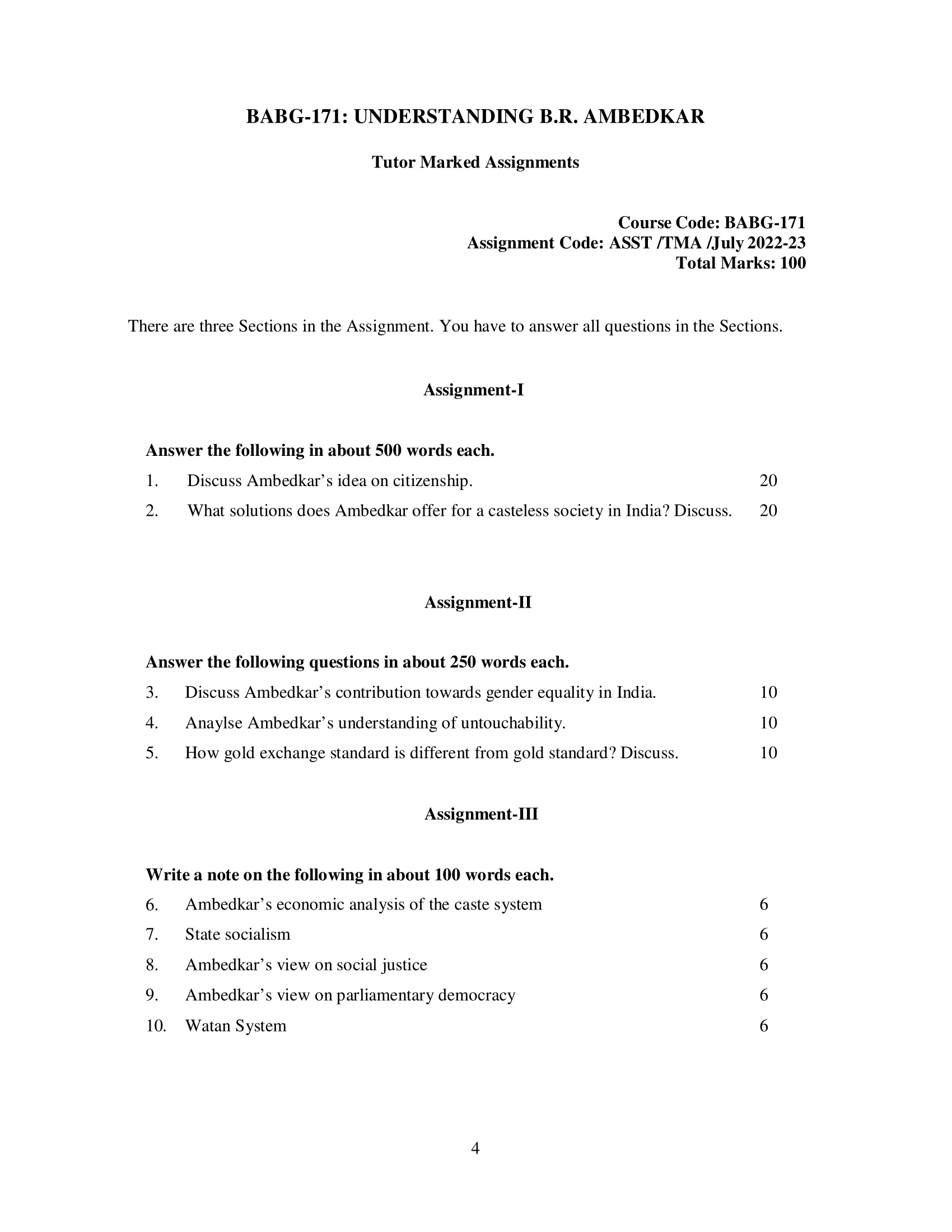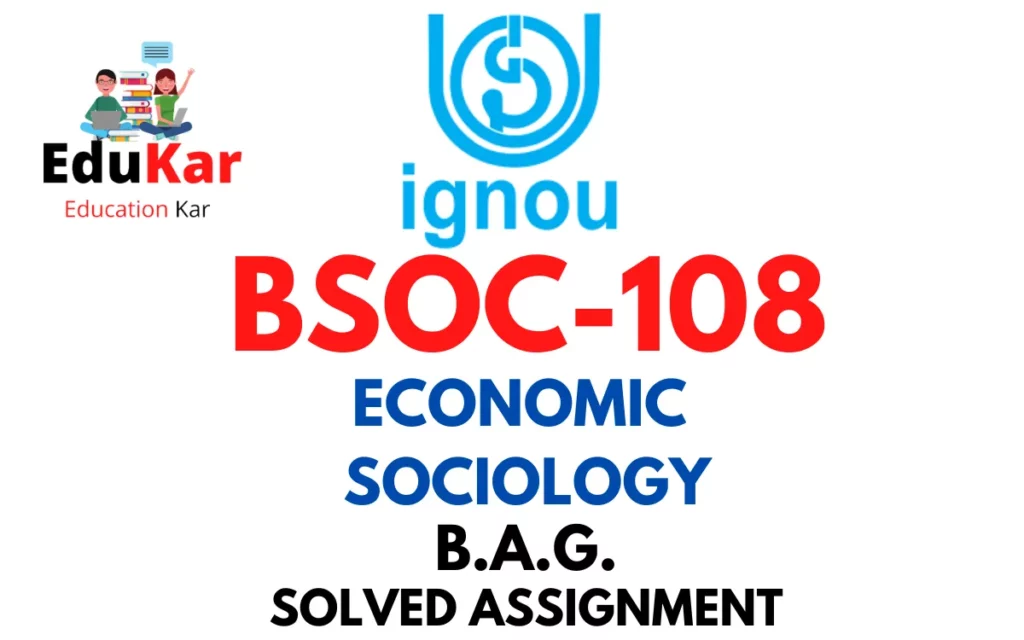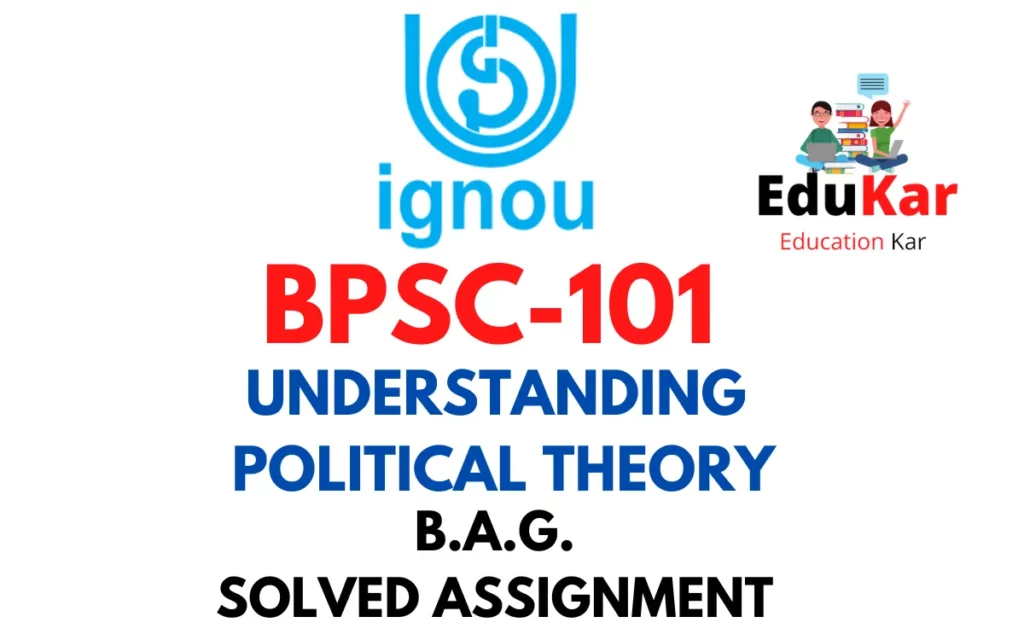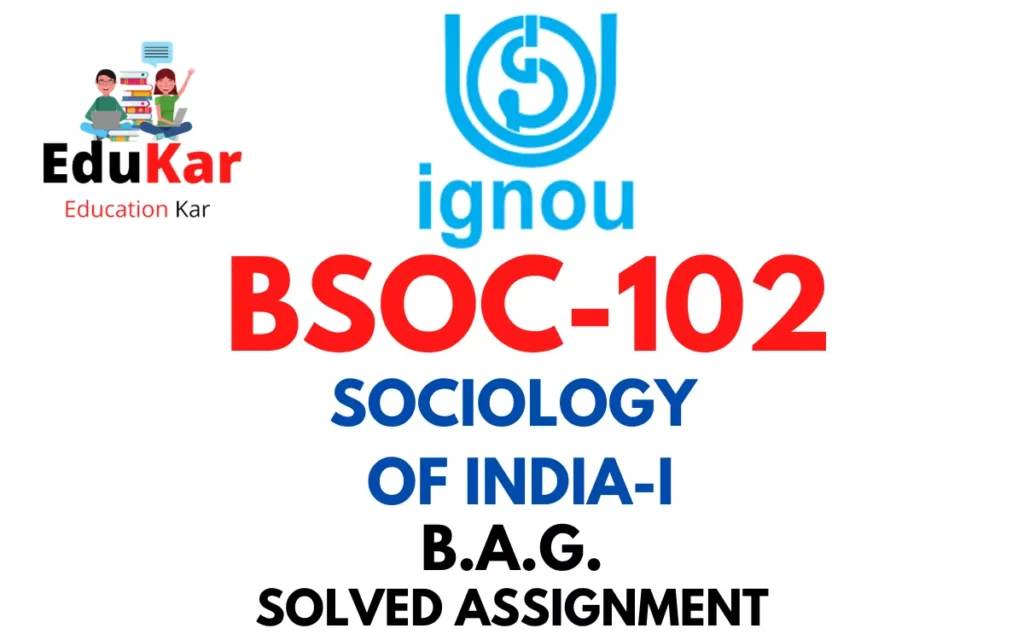Contents
- 1 Assignment-I
- 2 Answer the following in about 500 words each.
- 3 1.Discuss Ambedkar’s idea on citizenship.
- 4 2. What solutions does Ambedkar offer for a casteless society in India? Discuss.
- 5 Assignment-II
- 6 Answer the following questions in about 250 words each.
- 7 3. Discuss Ambedkar’s contribution towards gender equality in India.
- 8 4. Anaylse Ambedkar’s understanding of untouchability.
- 9 5. How gold exchange standard is different from gold standard? Discuss.
- 10 Assignment-III
- 11 Write a note on the following in about 100 words each.
- 12 6. Ambedkar’s economic analysis of the caste system
- 13 7. State socialism
- 14 8. Ambedkar’s view on social justice
- 15 9. Ambedkar’s view on parliamentary democracy
- 16 10. Watan System

| Title | IGNOU: BABG-171 Solved Assignment 2022-2023 (UNDERSTANDING B.R. AMBEDKAR) |
| University | IGNOU |
| Degree | Bachelor Degree Programme |
| Course Code | BABG-171 |
| Course Name | UNDERSTANDING B.R. AMBEDKAR |
| Programme Name | Bachelor of Arts (General) |
| Programme Code | BAG |
| Total Marks | 100 |
| Year | 2022-2023 |
| Language | English |
| Assignment Code | ASST /TMA /July 2022-23 |
| Last Date for Submission of Assignment: | For June Examination: 31st March For December Examination: 30th September |

Assignment-I
Answer the following in about 500 words each.
1.Discuss Ambedkar’s idea on citizenship.
Ans: Dr. B.R. Ambedkar, the chief architect of the Indian Constitution, had a strong and unique idea on citizenship that he propounded through his writings and speeches. According to Ambedkar, citizenship is not just a legal or political status, but it encompasses all aspects of social, economic, and cultural life of an individual. He believed that citizenship should be inclusive, guaranteeing equal rights and duties to all, regardless of their religion, caste, class, or gender.
Ambedkar was highly critical of the traditional caste-based Hindu society and saw it as a major barrier to achieving true citizenship in India. He argued that the caste system perpetuated discrimination and inequality, and that it must be abolished if India was to become a modern, democratic nation. He believed that citizenship in India should be based on the principles of liberty, equality, and fraternity, and that these principles must be reflected in the Constitution and in the laws and policies of the state.
Ambedkar was also concerned about the rights of religious and linguistic minorities in India, and he saw the need for constitutional guarantees to protect their rights. He believed that the state should be neutral and secular, and that it should not discriminate against any particular religious or linguistic group. He saw the importance of cultural diversity and advocated for the protection of the cultural rights of minority communities.
Ambedkar also emphasized the role of education in creating a truly democratic and inclusive citizenship. He believed that education was a means to empower individuals and to create a more equitable and just society. He saw education as a means to break down the barriers of caste and class, and to create a more equal and just society. He also saw the need for education to be universal, accessible, and of high quality, so that all individuals could participate in the process of nation-building and the development of the nation.
Ambedkar’s ideas on citizenship have had a profound impact on the development of India as a democratic nation. The Indian Constitution, which he helped to draft, reflects many of his ideas, including the principles of equality, liberty, and fraternity. The Constitution also provides for the protection of the rights of religious and linguistic minorities, and for the protection of the rights of women and other marginalized groups.
2. What solutions does Ambedkar offer for a casteless society in India? Discuss.
Ans: Dr. B.R. Ambedkar, one of the most influential figures in Indian history, was a strong advocate for the elimination of the caste system in India. He saw the caste system as a major barrier to the development of a truly democratic and equal society, and he dedicated much of his life’s work to finding solutions for a casteless society.
One of Ambedkar’s key solutions for a casteless society was education. He saw education as a means of empowering individuals and breaking down the barriers of caste and class. He believed that education could be used to create a more equal and just society, by providing people with the knowledge and skills they need to participate fully in the political and economic life of the nation. He also believed that education should be universal, accessible, and of high quality, so that everyone could participate in the process of nation-building and the development of the nation.
Ambedkar also believed in the importance of political action. He saw the need for laws and policies that would protect the rights of all individuals, regardless of their caste, class, or religion. He was a strong advocate for the protection of the rights of religious and linguistic minorities, and for the protection of the rights of women and other marginalized groups. He believed that the state should be neutral and secular, and that it should not discriminate against any particular religious or linguistic group.
Another key solution that Ambedkar offered for a casteless society was the promotion of inter-caste marriages. He believed that inter-caste marriages would break down the barriers of caste and promote greater social and cultural integration. He saw inter-caste marriages as a way of creating a more equal and just society, where individuals were not defined by their caste or religion, but rather by their individual abilities and achievements.
Ambedkar also saw the need for a change in social attitudes and beliefs. He believed that caste-based discrimination and prejudice could only be eliminated if people’s attitudes and beliefs changed. He encouraged people to question the traditional caste system and to challenge the prevailing social norms and values that perpetuated it. He also advocated for greater awareness and understanding of the rights of all individuals, and for the promotion of equality and justice in all aspects of life.
Ambedkar’s solutions for a casteless society continue to be relevant today, as India continues to grapple with the legacy of the caste system. The Indian Constitution, which he helped to draft, reflects many of his ideas, including the principles of equality, liberty, and fraternity. The Constitution also provides for the protection of the rights of religious and linguistic minorities, and for the protection of the rights of women and other marginalized groups.
Assignment-II
Answer the following questions in about 250 words each.
3. Discuss Ambedkar’s contribution towards gender equality in India.
Ans: B.R. Ambedkar, a social reformer and architect of the Indian Constitution, was a strong advocate of gender equality in India. He believed that women were equally deserving of the same rights, opportunities, and respect as men, and worked tirelessly to promote their equality in Indian society.
Ambedkar was a firm believer in the principle of equal rights and opportunities for women, regardless of their gender. He fought against the widespread practice of treating women as second-class citizens and advocated for their rights to education, employment, and political representation. He also spoke out against the oppressive and discriminatory practices against women in Hindu society, such as child marriage, sati (the practice of widows immolating themselves on their husband’s funeral pyre), and the caste system.
In the Indian Constitution, Ambedkar ensured that provisions were made to promote gender equality. The Constitution guarantees equality before the law and prohibits discrimination on the grounds of sex. It also provides for equal pay for equal work and equal inheritance rights for women.
Additionally, Ambedkar was a strong advocate for women’s education. He believed that women’s education was essential for their empowerment and that it would help to break down the barriers of patriarchal society. He stressed the importance of educating girls and providing them with equal opportunities to succeed, stating that “An educated woman is the mother of an educated society”.
Finally, Ambedkar’s legacy continues to inspire countless individuals in India and around the world who are working towards gender equality. His vision of a society where women are treated as equal citizens and enjoy the same rights, opportunities, and respect as men remains an important guiding principle for those who are committed to creating a more just and equitable world.
4. Anaylse Ambedkar’s understanding of untouchability.
Ans: B.R. Ambedkar, the architect of the Indian Constitution, was a strong advocate of human rights and a prominent voice against the caste system and the practice of untouchability in India. He believed that the caste system was one of the main obstacles to the progress and development of India and that the practice of untouchability was a violation of the basic human rights of Dalits (formerly known as “untouchables”).
Ambedkar understood that untouchability was a deeply ingrained social and cultural problem that had roots in Hindu religion and society. He saw that this practice not only excluded Dalits from participating fully in the social and economic life of their communities, but also subjected them to brutal and inhumane treatment, such as manual scavenging and exclusion from public spaces.
Ambedkar believed that the elimination of untouchability was essential to the creation of a just and equal society in India. He argued that untouchability was not only a moral wrong, but also a major barrier to the development and progress of India as a nation. He saw that this practice was a key factor in the widespread poverty, illiteracy, and social inequality that plagued India’s Dalit communities.
Ambedkar’s understanding of untouchability was shaped by his own experiences of discrimination and exclusion as a Dalit, as well as his extensive studies of Indian society and the caste system. He saw that the only way to eliminate untouchability was through a combination of legal and social change, including the abolition of the caste system and the creation of a more inclusive and just society where all individuals were treated with dignity and respect.
Ambedkar’s legacy continues to inspire those who are committed to promoting human rights and combating discrimination in India. His vision of a society where all individuals are treated equally, regardless of their caste or religion, remains a guiding principle for those who are working towards a more just and equitable world.
5. How gold exchange standard is different from gold standard? Discuss.
Ans: The gold exchange standard and the gold standard are two different monetary systems that were used to regulate currency in different parts of the world throughout history. Although they are similar in that they both use gold as a benchmark to regulate currency, they differ in significant ways.
The gold standard refers to a monetary system in which a country’s currency is directly backed by gold reserves held by the central bank. This means that individuals are able to exchange their currency for a set amount of gold at any time. The value of the currency is directly tied to the value of the gold, and changes in the supply of gold will affect the value of the currency.
The gold exchange standard, on the other hand, refers to a monetary system in which a country’s currency is backed by the central bank’s ability to exchange it for gold held by other countries. In this system, the central bank holds a limited amount of gold as a reserve, but can use its ability to exchange the currency for gold held by other countries to regulate the value of the currency.
The main difference between the two systems is that the gold standard requires a country to have a large amount of gold reserves, which can be difficult and expensive to maintain, while the gold exchange standard allows for greater flexibility and does not require a large gold reserve.
The gold exchange standard was used in many countries during the early 20th century and allowed for greater international monetary stability and economic growth. However, it was also subject to manipulation and was eventually abandoned in favor of floating exchange rate systems, in which the value of a country’s currency is determined by market forces.
Assignment-III
Write a note on the following in about 100 words each.
6. Ambedkar’s economic analysis of the caste system
Ans: Dr. B.R. Ambedkar believed that the caste system in India had a profound impact on the economic development of the country. He saw the caste system as a form of social division that created hierarchies of privilege and oppression, and he argued that it was a major obstacle to the creation of a just and equal society. Ambedkar’s economic analysis of the caste system emphasized the importance of breaking down the barriers of caste and class, so that all individuals could participate fully in the economic life of the nation. He saw education, political action, and cultural integration as key solutions for promoting greater economic equality and breaking down the barriers of caste and class. Ambedkar’s economic analysis of the caste system remains relevant today, as India continues to struggle with the legacy of the caste system and its impact on economic development and social equality.
Ans: State socialism is an economic system in which the state plays a central role in the control and ownership of the means of production. It is characterized by government ownership and control of key industries, such as natural resources, utilities, and heavy industry, as well as state control over the distribution of goods and services. The goal of state socialism is to create a more equal and just society, by ensuring that the wealth and resources of the nation are distributed more fairly. Proponents of state socialism argue that it provides a more stable and secure environment for workers, by ensuring that they have access to stable jobs, decent wages, and a social safety net. Critics, however, argue that state socialism can lead to inefficiencies, stifle innovation, and reduce economic growth, as well as erode individual freedoms and undermine political liberties.
Ans: Dr. B. R. Ambedkar, the father of the Indian Constitution, was a strong advocate for social justice. He believed that social justice is the foundation of a democratic society and that it should be the main goal of any government. He saw caste as a major impediment to social justice and fought for the rights of the Dalits (formerly known as untouchables) throughout his life. Ambedkar believed that political rights were necessary but not sufficient for achieving social justice. He argued that economic and educational opportunities must also be provided in order to create a truly equal and just society. Ambedkar’s ideas continue to influence the Indian government’s policies for the upliftment of marginalized communities.
9. Ambedkar’s view on parliamentary democracy
Ans: Dr. B. R. Ambedkar saw parliamentary democracy as the best form of government for India. He believed that it would ensure the representation of all sections of society and prevent the concentration of power in the hands of a few individuals. Ambedkar saw democracy as a means of empowering the people and giving them a voice in the decision-making process. He was a strong advocate for the rights of minority groups and believed that a parliamentary democracy would provide them with the necessary protections and representation. Ambedkar was also aware of the challenges posed by communal and sectarian interests, and he believed that a parliamentary democracy, with its system of checks and balances, would be best equipped to address these challenges. In his view, a parliamentary democracy was the key to achieving social justice and equality in India.
10. Watan System
Ans: The Watan System was a system of land ownership and control in India during the British colonial rule. It involved the granting of land to individuals or groups, known as watandars, in exchange for their loyalty and service to the colonial government. The watandars were responsible for maintaining law and order in their designated territories, collecting taxes, and providing military support to the colonial government.
This system allowed the British to maintain control over large parts of India with minimal investment and manpower. However, it also created a class of privileged watandars who enjoyed significant power and influence, and often oppressed and exploited the local populations. The Watan System was abolished after Indian independence in 1947, but its legacy continues to shape the social and political landscape of many regions in India today.
How to Download BABG-171 Solved Assignment 2022-2023 (UNDERSTANDING B.R. AMBEDKAR) Solved Assignment?
You can download it from the www.edukar.in, they have a big database for all the IGNOU solved assignments.
Is the BABG-171 Solved Assignment 2022-2023 (UNDERSTANDING B.R. AMBEDKAR) Solved Assignment Free?
Yes this is absolutely free to download the solved assignment from www.edukar.in
What is the last submission date for (IGNOU-BAG) Solved Assignment?
For June Examination: 31st March, For December Examination: 30th September
















